昨天介紹了 Flux 架構和它的實作套件 Redux。最後我們寫了簡單的 Redux 程式,體驗 Redux 如何運作。以 Flux 架構圖來說, 昨天的內容是
今天我們要專注在與 React 的串接
我們實際引入 Redux 到之前的 hello-react 專案中
redux: 建立 Reducer, Store複制 Day 11 - 一周目- 開始玩轉前端(二) 的專案 hello-react
安裝 Redux: npm install redux --save
建立 RootReducer.js,放在 reducers/RootReducer.js
// reducers/RootReducer.js
const initState = {};
const reducer = (state = initState, action) => {
const {type} = action;
switch (type) {
default:
return state;
}
};
export default reducer;
這裡我們建立了一個 RootReducer,不打算合併其它的 reducer。若你需要更有結構的 state,你可以用 combineReducers 合併多個 reducer。以 const rootReducer = combineReducers({ login: LoginReducer, account: AccountReducer,}) 來說, state 是巢狀物件,它有 login、account 分別可以索引到 LoginReducer、AccountReducer 裡面的 state。
開一個 stores 資料夾,建三個檔案 configureStore.js、configureStore.prod.js、configureStore.dev.js
// stores/configureStore.js
if (process.env.NODE_ENV === 'production') {
module.exports = require('./configureStore.prod');
} else {
module.exports = require('./configureStore.dev');
}
// stores/configureStore.prod.js 和 stores/configureStore.dev.js
import { createStore } from 'redux';
import RootReducer from '../reducers/RootReducer';
export function configureStore(initialState) {
const store = createStore(
RootReducer,
initialState,
);
return store;
}
我們未來只要 import {configureStore} from 'stores/configureStore' 就可以依照環境變數 NODE_ENV,選用 store。因為是同樣的程式碼,當 Redux DevTools 引入時就會不一樣。
react-redux:把 Store 送入 View 中之前只安裝了 Redux 的 Reducer 和 Store,但最後我們要把 Store 送到 Controller-View 中,這樣 Controller-View 才可以用 store 拿出 state (store.getState()) 和 dispatch action (store.dispatch(action))。
為了完成這件事要用到 React Context,這是由 React 提供的,它的功用是在 component tree 中的上層把值送入後,底下的所有 subcomponent 任何一層都可以拿的到這值,而不用一個個傳遞下去。
舉官方例子: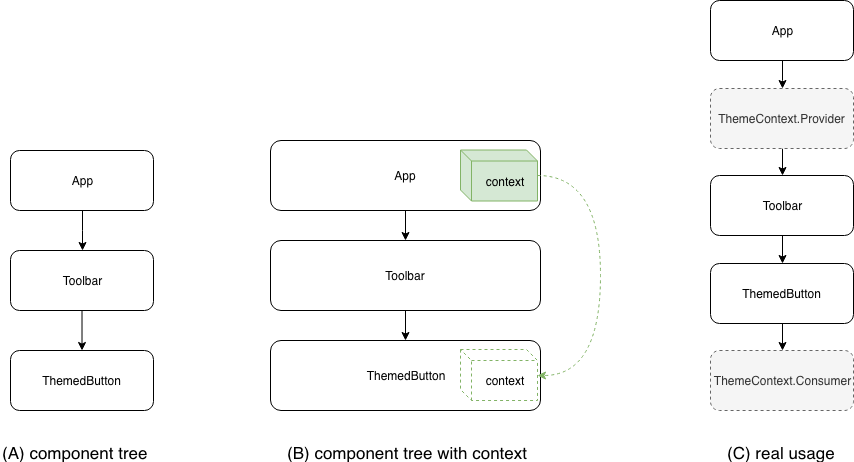
(A)圖是本來的 component tree, 假設有個 theme value 要從 App 送 到 ThemedButton 中,用 Context API 後邏輯上就是 (B) 圖,實際使用Contenx API 就是 (C)圖。
// 建立一個 Context
const ThemeContext = React.createContext('light');
class App extends React.Component {
render() {
// 使用 ThemeContext.Provider 把值送入
return (
<ThemeContext.Provider value="dark">
<Toolbar />
</ThemeContext.Provider>
);
}
}
// 這是中間層的元件,不用把值送到 <ThemedButton/> 中
function Toolbar(props) {
return (
<div>
<ThemedButton />
</div>
);
}
// 這是下層的元件,只要用 ThemeContext.Consumer,就可以取出值
function ThemedButton(props) {
return (
<ThemeContext.Consumer>
{theme => <Button {...props} theme={theme} />}
</ThemeContext.Consumer>
);
}
回到 Redux,一般來說我們也要做類似的事情,但有大神們開發了 react-redux 套件幫我們把 Store 送入 View 中,我們甚至不會察覺到 context 的存在。
react-redux: 串連 redux 和 reactreact-redux 提供兩個好用的函數:
Provider:我們再也不用建立 Context,直接用庫提供的Provider <Provider store={store}> 送入 storeconnect(mapStateToProps, mapDispatchToProps)(component):連接 state 到 component props 和連接 「dispatch行為」 到 component props (指事件的 callback props, ex: onClickButton,要執行派發 action)。 更明確地說,這 API 結果就是回傳 <component {...mapStateToProps()} {...mapDispatchToProps()} />
其實,
connect是 high-order component (HOC),它輸入 component 送出 component。見重構 React component 邁向 Prue/Container component 和 HOC
開始套用吧~
npm install react-redux --save
./index.js,建立 store,放入 <Provider store={store}>
// index.js
import { Provider } from 'react-redux';
ReactDOM.render((
<Provider store={store}>
<App />
</Provider>
), document.getElementById('root'));
Controller-View (component) 雖然沒有存 state,但它與 store 串連,所以它邏輯上來看就好像有自己 state,所以也可以稱為 Container。反之,完全沒有 state 的 component,被稱為 Pure component。
components/LoginBox.js
import React, { Component } from 'react';
class LoginBox extends Component {
render() {
return (
<div>
message: {this.props.message}
</div >
);
}
}
export default LoginBox;
containers/LoginBox.js
import { connect } from 'react-redux';
import LobinBox from '../components/LoginBox'
const mapStateToProps = (state) => {
return {};
};
const mapDispatchToProps = (dispatch) => {
};
export default connect(
mapStateToProps,
mapDispatchToProps
)(LobinBox);
App.js 中使用 LoginBox Container
import LoginBox from './containers/LoginBox'
class App extends Component {
render() {
return (
<div className="App" >
Hello React: {this.state.name}
<LoginBox />
</div >
);
}
}
因為 LoginBox container 的 message 的值我們還沒有設定,所以你打開 npm run start,只會看到
RootReducer 中設定 message state 變數和它初始的值
// reducers/RootReducer.js
const initState = {
message: 'init message',
};
...略
// containers/LoginBox.js
const mapStateToProps = (state) => {
return {
message: state.message,
};
};
...略
RootReducer 中定義的 state。connect(...)(LoginBox) 就好像把 message 送入 LoginBox pure component, ex: <LoginBox message={state.message} />
結果如下:
假如我們按一個 Button 就要改變 message 的值。
在 LoginBox 加入一個 Button 和定義一個 onClickSubmit callback
class LoginBox extends Component {
render() {
return (
<div>
message: {this.props.message}
<button onClick={this.props.onClickSubmit}>Submit</button>
</div >
);
}
}
開一個 actions 資料夾,建立 LoginBoxActions.js
export const identityOnClickSubmit = 'identityOnClickSubmit';
export function onClickSubmit(data) {
return {
type: identityOnClickSubmit,
payload: data,
};
};
我們很刻意的把資料放到
playlod中(叫data也可以),這不是一定要這麼做,只是為了保留最外層是 action 的專用屬性,防止data內也有type屬性干擾 action 最外層屬性。另外也有個好處,data是陣列時,就有通用屬性名playlod可以取出陣列。
在 LoginBox container 指定要使用 onClickSubmit 來派分(dispatch)一個 action
...略
const mapDispatchToProps = (dispatch) => {
return {
onClickSubmit() {
dispatch(actions.onClickSubmit({message: 'clicked'}));
}
}
};
...略
RootReducer 要監控這個 action (即 identityOnClickSubmit)
import * as actions from '../actions/LoginBoxActions';
...略
const reducer = (state = initState, action) => {
const {type, payload} = action;
switch (type) {
case actions.identityOnClickSubmit: {
const {message} = payload;
return Object.assign({}, {message});
}
default:
return state;
}
};
結果如下:
按下Submit,message 改變了
最後看一下我們做了什麼?我們建了 Sore/Action/Container/Components 資料夾,來附合 Flux 架構,大部分 Flux 架構的前端專案都有類似的資料夾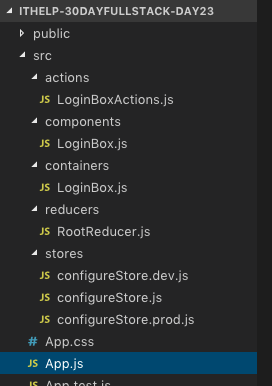
Redux DevTools 用來看 Redux 運作,更明確的說,它在監控「dispatcher 和 action 的運作」及「action 如何影響 state」。馬上來試試看:
createStore() 中加入 store enhancer
// stores/configureStore.dev.js
import { compose, createStore } from 'redux';
import RootReducer from '../reducers/RootReducer';
const composeEnhancer = window.__REDUX_DEVTOOLS_EXTENSION_COMPOSE__ || compose
export function configureStore(initialState) {
const store = createStore(
RootReducer,
initialState,
composeEnhancer()
);
return store;
}
createStore(reducer, initialState, enhancer)第三個參數是 enhancer,拿來套用第三方的套件,修改 store creator,它是 hight-order function,它結合 store creator 成為另一新的 store creator。 store enhancer 簽章如下:
function StoreEnhancer(next: StoreCreator): StoreCreator
createStore(reducer, initialState, enhancer) 就像是 enhancer(createStore)(reducer, initialState),enhancer(createStore) 變成新的 store creator。(見原始碼)
compose() 是拿來以合併 store enhancer 用的。舉個例子:compose(Enhancer1, Enhancer2)(createStore) => Enhancer1(Enhancer2(createStore))
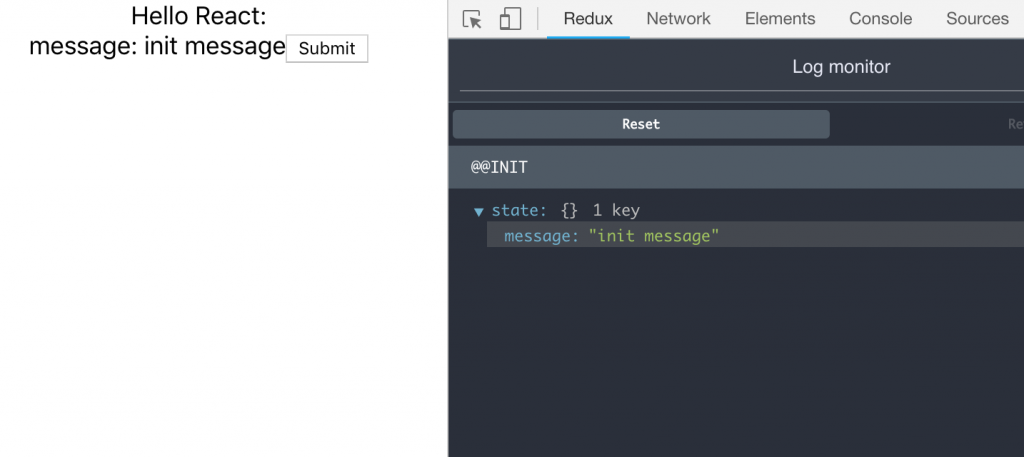
identityOnClickSubmit)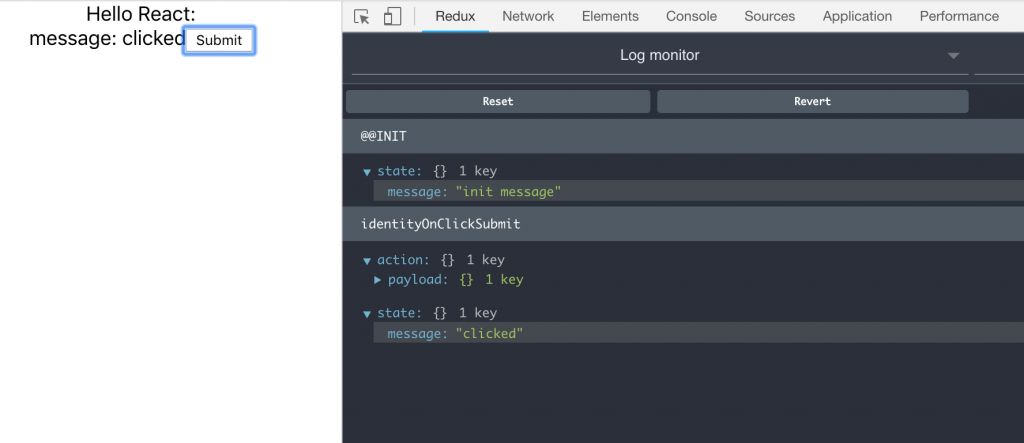
Redux DevTools 有三種模式
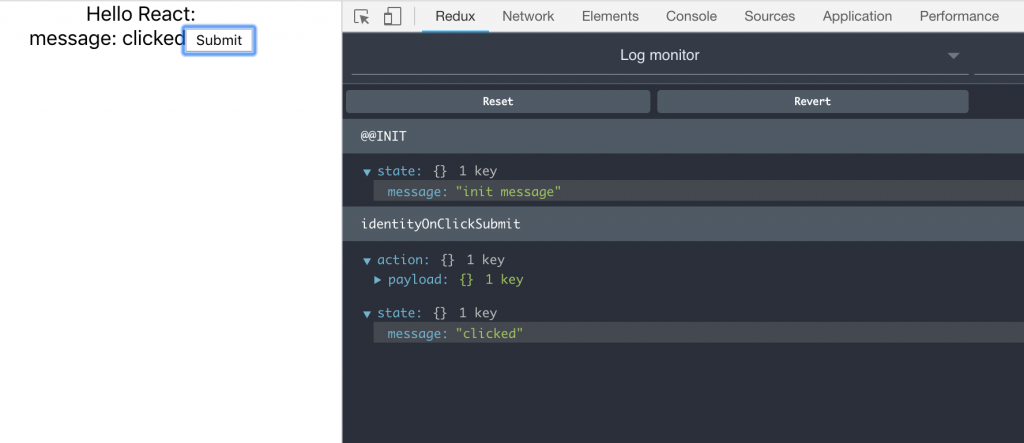
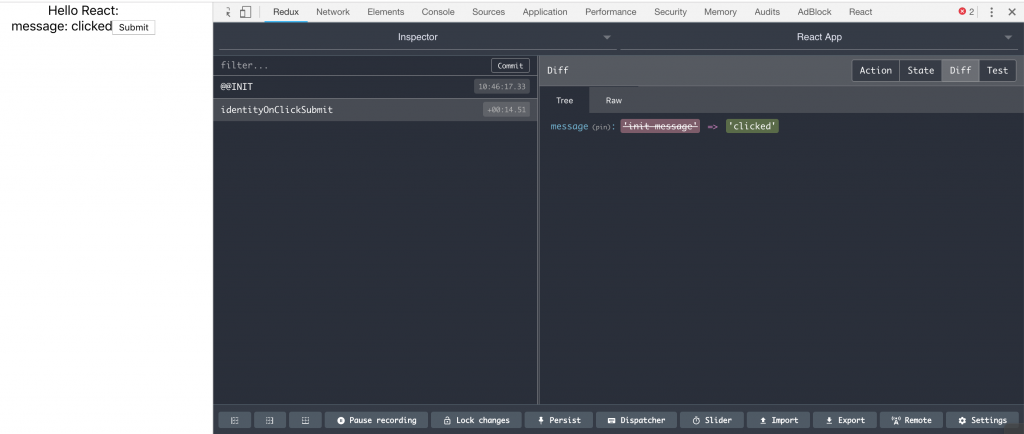
combineReducers()) 會讓 state 是巢狀 object,這模式可以看 state 結構和各個 state 值。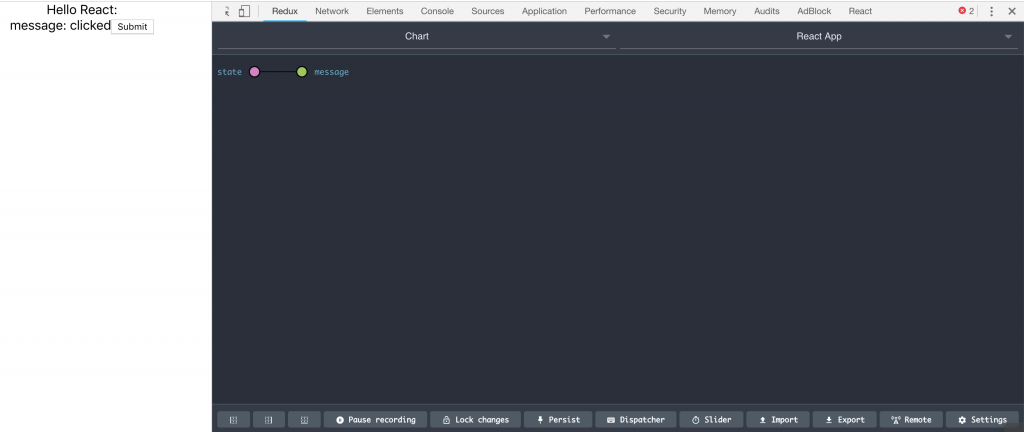
每個模式都有它特別的地方,自己玩看看。
今天我們實際串接 Redux 和 React,利用 react-redux 套件,就不需要自己寫 React Context。為了確保有運行,我們還裝了 Chrome extension Redux DevTools,可以查看 Redux 的運作。
